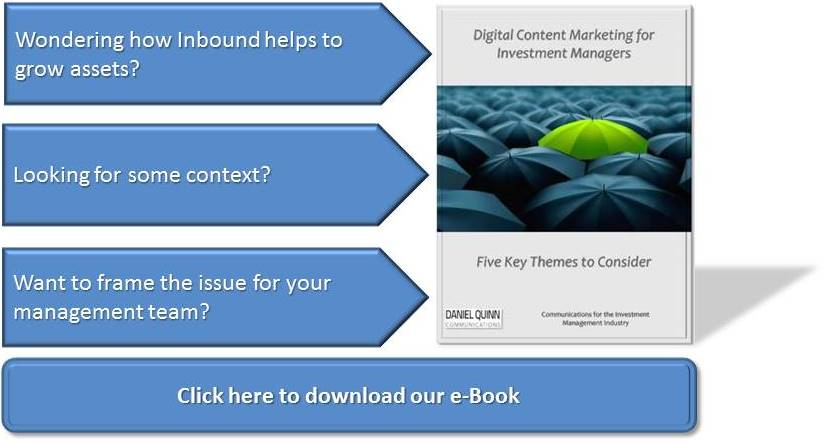
While inbound marketing for investment managers is a strategy that’s been tested and has offered real results across many industries, it is a marketing strategy whose path to success is fraught with pitfalls and unseen obstacles.
Let’s take a look at the fictional asset management firm, DQ Capital. Does anything in this asset management content marketing campaign seem eerily familiar… ?
DQ Capital is an institutional asset management firm with 3 portfolio managers, (one of whom doubles as the sales and marketing director), one sales and marketing associate, 2 investment analysts, a trader, and a compliance / office manager. They have a 10-year track record, 10 institutional clients, and $2.5 billion in AUM.
Their performance has been in the top quartile in 8 of the past 12 quarters, and top decile 6 times. The fund has generated positive returns since inception – no small feat since their fund was launched only 18 months before the subprime loan scandal crashed the stock market and economy in 2008.
The partners all agree that their current AUM does not reflect the fund’s long-term performance. Also, it is agreed that the firm’s asset base must become more diversified – their top two clients account for more than half of total AUM. If something unexpectedly bad happens, they’re sunk.
The firm’s sales & marketing team has been studiously performing all of the marketing tasks that are standard for the investment management industry: calling consultants, completing RFPs and RFIs, updating their database profiles, researching competitors, writing the occasional press release or client letter (posted to the website, of course), promoting the most recent interview with a local publication, etc., etc., etc.
But it is becoming clear that letting their performance speak for itself hasn’t yielded the results it should. It is also obvious that their existing marketing effort has barely moved the needle over the past few years, other than getting approved by a few consultants and having somewhat deeper industry ties.
They one day get a call from a writer who makes a convincing case for a new website and revamped messaging. Four months later, the new site is up, the new messaging intact. After another three months, the needle remains stuck, as the number of visitors to the site is small, and none have converted to actual sales leads, that they know of.
Wondering how they can better leverage their website as a marketing tool, they do some online research and become intrigued by the idea of blogging; using it to establish their thought leadership, and thus some differentiation from their competitors.
In any case, blogging certainly seems like something that many successful, growing firms are doing, which is a powerful argument for the firm's principals.
So the firm hires their old website developer to add a blogging module to their site, and the portfolio managers alternate writing weekly blog posts about the market, investing generally, current events affecting the portfolio, long-form discussions of their investment philosophy and process, and a smattering of posts more personal in nature (e.g. an experience volunteering in a soup kitchen on Thanksgiving, and how we all have much to be thankful for).
They check their analytics and see that each post is only getting 3-4 hits, if any at all. And after 6 weeks or so, quarter end rolls around and the PMs become preoccupied with reporting, client meetings, database updates, etc.
Unsurprisingly, the blogging effort loses its momentum, both because of other more pressing duties and also because they just aren’t seeing the ROI for the time invested.
So for another three months the blog lies dormant. Hoping to jump start their effort, the firm hires the freelance writer who consulted on their new website content and messaging a while back. But after a month or two, the principals decide his work simply didn’t ring true and wasn’t reflective of the firm’s thinking. They terminate the relationship.
So now, more than a year has passed and all of DQ Capital’s investments in their new marketing strategy seem to have been an utter failure. So they abandon the blog, the routine website updates (figuring nobody’s looking anyway), and go back to “what’s worked for them in the past.”
In essence, DQ Capital represents one of my buyer personas; in part, it is a firm that is open-minded and has the confidence and the resources to undertake an inbound marketing campaign.
Only in this case, their experience going it alone soured the firm’s decision makers on the promise of inbound marketing for asset management firms. In my business, this would be a prospect I’d look at and say, “I wish I’d called them last year…”
In my next post, I will deconstruct everything that went wrong, and show how, with a few tweaks and a better strategic foundation, DQ Capital would have experienced dramatically different results.
Has your investment management firm been in this situation? Can you see shades of your effort here, or are afraid this is how the effort would turn out? Want to better understand the issue? The best place to start is at the beginning:



